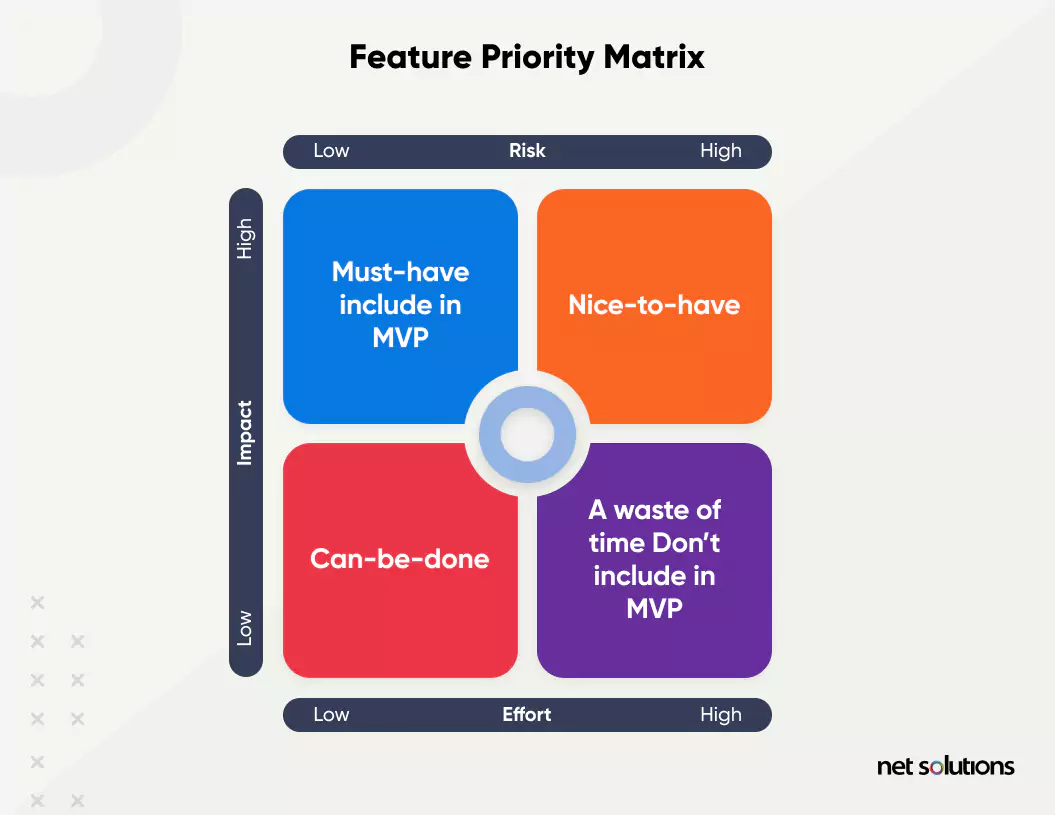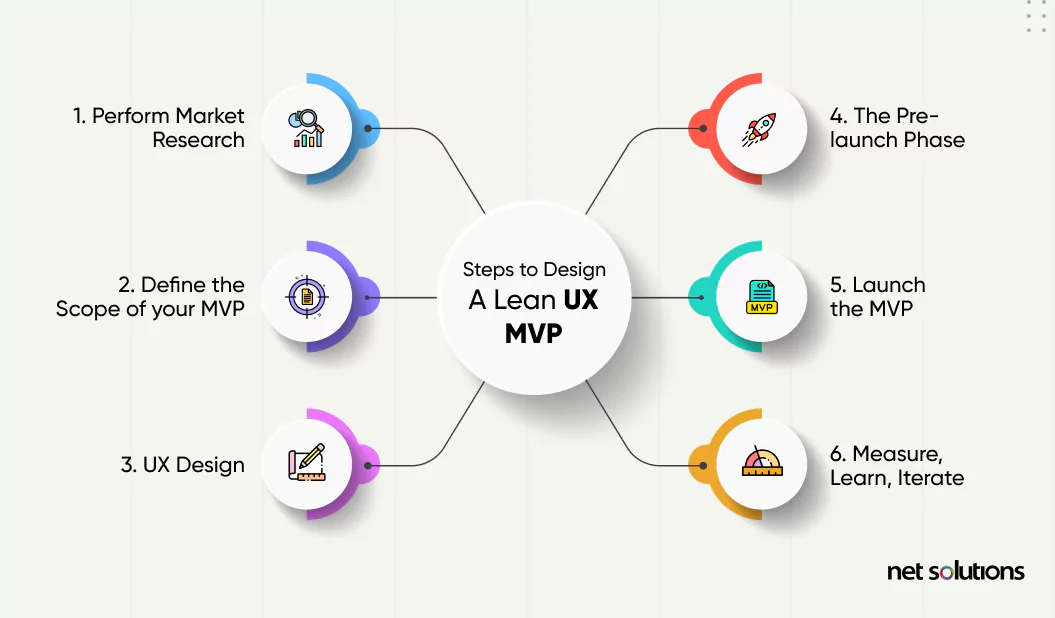User Experience (UX) design isn’t always the first thing entrepreneurs consider when creating a Minimum Viable Product (MVP), but it plays an essential role in validating a new product idea and gathering feedback.
A well-considered UX and a simple but functional User Interface (UI) create a seamless user journey. Ideally, new users can painlessly access the software, figure out how to use it without much effort, and evaluate your solution. Tried-and-true UX design principles are key to making this happen.
Key Takeaways
- Base your product on solid market research
- Test all your assumptions and let your target audience guide you
- Focus on your core features
- Build a highly usable MVP (because minimum viability doesn’t mean sloppy)
- Be flexible and iterate based on feedback
Why Is UX Important in MVP Development?
It may be tempting to consider UX a luxury when it comes to MVP development, but that is a common misconception. The reality is that a clean, intuitive user journey is essential to validating a new software product.
After all, if users don’t understand how your product works, they’ll simply give up—and you may abandon a perfectly good product idea that would have gathered traction with the right UX.
Of course, since the UI will probably be simple, your UX requirements won’t be as extensive as those of a full-fledged product. The point is to use UX best practices to ensure a smooth, intuitive customer journey.
7 UX Design Tips to Create Better MVPs
Lean UX Design is a way of thinking about product creation, guided by certain principles that have produced some of the world’s most influential and successful products. Spotify, for example, was built using the Lean UX Design methodology.
The following are seven guidelines that will help you create better software based on UX Design principles, infused throughout the Lean UX Design philosophy.
- Focus on the actual user needs
There’s a core concept in modern product development that guides most successful product creation efforts: There is more innovation out in the world than in your meeting rooms.
In other words, consumers know what frustrates them, and the next big idea for a successful product lies in addressing their frustrations and solving their problems. Build a product with your customers in mind, and design your core features (and every subsequent set of features you introduce) around their needs.
Of course, drawing a line between what we think the user needs and what the user actually needs can be challenging. We may think we’ve figured out what the user wants, but it later turns out to be something else entirely. Hence, you should start by challenging your assumptions about user needs.
One efficient approach is to focus on their pain points. That’s where research plays a crucial role. Here’s how you can approach the research:
- Ask yourself what problem your target customers are facing and how you can solve it
- Check out the existing apps and see which problems they fail to solve
- Talk to people who are going to use your product. They know better what they need
For example: Suppose you’re thinking of creating a to-do list app. Now, instead of automatically assuming you need to create an app for to-do lists, determine the customers’ major problems. Perhaps, it’s forgetting something important or wasting mental energy keeping track of things.
Once you have the answer, you can devise an effective solution for their problem. To ensure your solution works, test it with real people. This way, you can put your time, effort, and money into a product that works for your customers.
- Do a few things, but do them well
In this age of information abundance and overload, those who get ahead will be the folks who figure out what to leave out, so they can concentrate on what’s important to them.
— Austin Kleon
The crux of an MVP lies in this statement: An MVP is a probe for feedback on your vision. A probe is defined as an attempt to discover information by asking a lot of questions. And that makes sense in the case of an MVP.
When building a probe, the major challenge is to strike a balance between speed of delivery and quality of execution. Entrepreneurs face the common challenge of distilling their vision, narrowing an abundance of ideas down to just a few. To achieve this goal, learn to say “no.”
List things you will not do during the MVP Development Process. It helps streamline the design process as everyone will have a clear idea of what resides in the product’s core. In this way, you can make better decisions and not take your eye off the target. Agreeing on a specific UX design process for product development can be a great way to make smarter and quicker decisions.
Feature prioritization in MVP is the act of evaluating which features to focus on building, and there are a number of feature prioritization techniques that can help you choose where to spend your time and resources.
One excellent feature prioritization tool is the feature prioritization matrix, which involves creating a chart that categorizes features according to two key factors: Impact and Risk. Risk, in software development describes the challenges you may face along with the resources required to develop a feature.
Ideally, you should focus on creating features with the highest impact but minimal risk. Of course, if your core feature set is high-risk but so impactful that it defines your product, then you have no choice but to create it.

- Consider both your findings and the users’ needs
To create an MVP, most designers start with a list of features and product needs. While that’s not a bad place to start, you should also be mindful of what customers want from your product.
Knowing what customers want is not difficult. You can conduct interviews, surveys, and brainstorming sessions. Discussion forums and platforms like Quora and Reddit are also great places to start. Once you have enough ideas, compile them into a list and narrow down which ideas are technically feasible. Then, based on this information, you can start building your MVP.
Note: While listing the features customers want in your product, make sure the list doesn’t just include good ideas. Sometimes, bad ideas can also lead to innovative solutions.
- Keep it simple
“Everything should be as simple as possible, but no simpler.”
— Albert Einstein
A Minimum Viable Product acts as a “waste-reduction tool,” but often, startups mistake an MVP for quick, sloppy design and shift their focus away from a user-centric approach. One vital factor that gets sacrificed in this approach is visual design.
Visual design starts to play a role in the first phase of MVP Development: idea validation. In this stage, an entrepreneur attempts to validate a business idea before proceeding.
As noted by Buffer’s founder Joel Gascoigne, one way to do this is to use a simple yet interactive and visually pleasing landing page that asks users to leave details if they’re interested in the value proposition. Rather than launching a product he hadn’t validated, he used a simple, aesthetic landing page to learn what users thought.
The design doesn’t need to be stunning, with cutting-edge visual effects. Instead, the design of a Minimum Viable Product should stand on the basic principles of visual design: Unity, balance, hierarchy, proportion, emphasis, and contrast.
A design that meets all these requirements helps the user understand the product easily, achieving a good first impression and building trust.
- Make your MVP usable
Both Lean UX and MVP development encourage building usable products. As such, you should ensure that your product’s MVP solves real customer needs.
Start with listing features that solve users’ most critical pain points. Also, avoid stuffing too many features into your MVP. It should only focus on features you think will have the highest ROI. You will iterate in the future based on user feedback and behavior, assuming you validate your idea.
- Stop thinking about the final product
Thinking about the final product can be tempting. However, the downside is that it can limit innovation and creativity.
Instead of thinking outside the box, designers may go in with preconceived notions or approaches that save time. This leads to a subpar MVP and a low-quality product. So, stop thinking about the final product and let your creativity run wild. That way, you can work toward an innovative product that offers users what they want.
- Always welcome feedback
Good user research is key to designing a great User Experience. Designing without good user research is like building a house without solid foundations. Your design will soon start to crumble and eventually fall apart.
— Neil Turner
All the best practices linked to Lean UX (measuring and validating a product) and Agile MVP development (fast, iterative delivery) serve two main purposes.
The first goal is to validate or invalidate a hypothesis (i.e., a potential solution for the market). The second goal is to gather feedback on your product so you can improve it with each iteration. That’s why MVP testing is so vital. It helps you evaluate user behavior and determine what they’re looking for in your solution.
To maximize the benefits of gathering feedback, follow these tips:
- Test your prototypes on the right people
- Be neutral when presenting your ideas
- Ask the right questions
- Let the user contribute ideas
All this data from your early adopters will help you validate your idea and create a powerful product, improving each iteration to serve your customer base.
Why is Lean UX Design Important in MVP Functionality?
The Lean methodology goes hand in hand with MVP software development, and quality Lean UX Design is essential to the MVP process because usability impacts functionality.
That shouldn’t come as a surprise. As much as techies love to imagine that a product’s core functionality speaks for itself, the reality is people won’t understand how to use your product if it isn’t obvious and reasonably intuitive.
We’re not saying your MVP UX needs to be flawless, but it should be easy to grasp for first-time users. You need to consider the user journey carefully, and your MVP should feature a simple but effective UI design so your initial users can solve the problem your product addresses.
That’s the role of UX in building an MVP, and that’s why working with a talented user experience design team will help you validate your product idea and move forward with iterations based on feedback.
How to Design a Lean UX MVP
Creating an MVP with Lean UX Design principles in mind will help you connect with an audience with a problem you can solve.
An intuitive, straightforward MVP focusing on one or two features will help you validate your idea and gather feedback for future iterations. The following six steps will guide your efforts and help you create an MVP that does exactly what an MVP should do.
Step 1: Perform market research
Market research is key to creating any digital product, and it also plays an essential role in a Lean UX design approach. With this in mind, market research for a new product consists of two major elements: Understanding your target audience and the competitive landscape. Here’s how you can gather intelligence on both elements.

You can understand potential users through:
- Surveys
- Focus groups
- Interviews with the target audience
- Published research data
- Feedback on existing products (if you have any)
You can learn more about the competitive landscape by:
- Researching competitors and exploring their websites
- Signing up for similar products and identifying what they’re missing
- Reading published research and data on companies in this space
Market research will help you identify user problems and increase your odds of addressing them in ways where existing products fall short. Simply building a product based on a hunch about what the market needs is a recipe for failure.
Step 2: Define the scope of your MVP
Clearly identify the scope of your project, including the problem you’re trying to solve and the core features you want to include in your MVP. Keep your scope focused on must-have features, rather than nice-to-have ones.
As your design and development teams get into the project, they may be tempted to start adding features that go beyond the scope you’ve set—especially if key stakeholders start requesting them. If this happens, return to the scope you defined in this step and review it.
Don’t be afraid to have challenging conversations about whether additional features are truly necessary to validate your idea and gather feedback because each time you add new features, the budget expands and your time to market increases. Stay focused on your purpose, your key features, and your target audience’s needs.
Step 3: UX design
UX design begins with usability testing, which requires prototypes.
Low-fidelity prototypes may consist of sketches of the UI, asking prospective users to make decisions about where to click and what to do to accomplish their goals. High-fidelity prototypes come close to emulating the genuine user journey with graphics that closely resemble a real software product.
UX research will help you identify what works and what doesn’t work before sending the designs to your development team, who will turn them into a working MVP.
Step 4: The pre-launch phase
Once you’ve built your MVP, it’s important to conduct user testing—which is very different from the UX research in the previous step because at this point, instead of prototypes, users are evaluating a working product.
Consider using a combination of moderated and unmoderated testing to gather feedback from prospective users. Based on their input, your design and development teams may change a few things to ensure a high level of usability.
Step 5: Launch the MVP
Once you’ve made your final adjustments to the UX and UI, and after you’ve completed QA testing, it’s time to launch your product.
You can choose to launch it to a wide audience, or you can offer a limited release to a handful of users. Either way, be sure to target your ideal audience since it’s their feedback that will prove valuable.
Step 6: Measure, learn, iterate
As with any MVP, the goal is to validate your product and learn from your audience—gathering feedback that will help you improve and iterate with each subsequent release.
There are many MVP tools on the market that will help you gather feedback and evaluate user behavior, such as Hotjar and Crazy Egg. Whichever products you use, be sure to ask insightful questions about the User Experience and prioritize all new feature ideas strategically.
Looking to design an MVP that uses solid UX principles?
Net Solutions has been designing and developing software products that deliver a powerful User Experience for more than two decades. We’ve worked with household names like the Harvard Business Review and IMG, and we’ve developed countless MVPs for startups like Soaq and Scoff.
Ready to get started with your MVP? We can spearhead the entire process or work on specific elements like UX research, UI and UX design, development, testing, or any other stage in your MVP project.
Frequently Asked Questions (FAQs)
1.What makes a good MVP in UX Design?
A good MVP incorporates UX best practices, allowing customers to use the software without any hassle or confusion. Its UI and UX are intuitive, clean, and as simple as possible. Ideally, designers have tested prototypes and gathered feedback before launching.
2.How does Lean UX start?
Lean UX starts with market research and ideation. One core principle of Lean UX is that you need to find and solve a problem the market doesn’t currently address. That means understanding user needs as well as the competitive landscape. Your proposed solution becomes your “hypothesis” in Lean UX terms, and you’ll test that hypothesis with an MVP.
3.What are the main rules in MVP product design?
While there are no specific rules to MVP design, there are some overarching guidelines that help design and development teams create a successful MVP. Some of those guidelines include making informed, market-driven decisions about the problem you want to solve, gathering feedback, and refusing to make unfounded assumptions about what the market wants.
4.How can I measure the success of my MVP?
Plenty of tools exist to help gather and evaluate customer feedback, including customer survey tools like Hotjar (mentioned above) and A/B testing tools like ABTastey.
To measure success over time as you iterate, you’ll want to focus on important metrics, such as Customer Satisfaction (CSAT), customer churn, Net Promoter Score (NPS), Cost Per Acquisition (CPA), or Key Performance Indicators (KPIs).
SHARE THIS POST
Table of Contents
Related Resources
- What Is an MVP App? A Guide to Building Successful Products
- A Deep Dive Into 7 Minimum Viable Product Benefits
- A Step-by-Step Guide to Build a Minimum Viable Product (MVP)
- 19-Step Minimum Viable Product (MVP) Checklist [With PDF]
- How Much Does a Minimum Viable Product (MVP) Cost? Here’s the Answer
- 10 Top MVP Development Companies [Great for Startups]
- 10 Minimum Viable Product (MVP) Examples You Should Know
- The Ultimate Guide to Developing an MVP in Agile: What, How, and Why
- A Step-by-Step Guide on how to Master Your MVP Launch in 2025
- How to Prioritize Features for Your Minimum Viable Product (MVP)
- How to Test an MVP: 15 Proven Strategies that Work
- 20 Great MVP Tools to Help You Create & Launch Your Product
- 11 different Types of MVPs to Kickstart Your Software Project
- MVP Website: Benefits, Best Practices, How to Build & More

